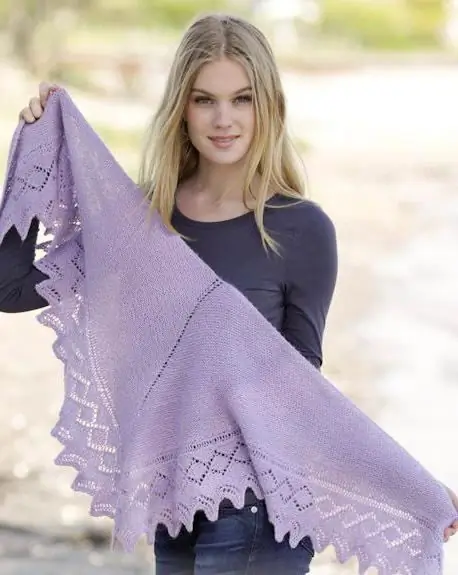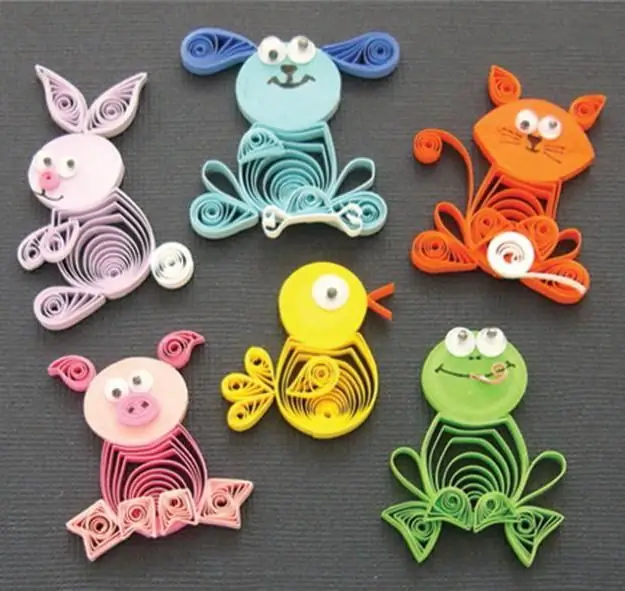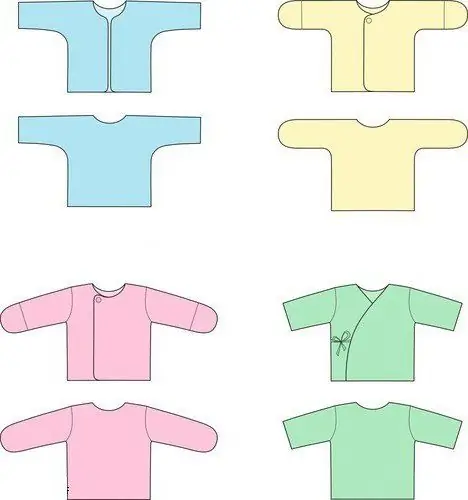
Inhaltsverzeichnis:
- Arbeiten mit Strickwaren
- Werkzeuge zum Nähen von Strickwaren
- Stoffe zuschneiden
- Nuancen der Strickwarenschneiderei
- Kleid ohne Muster
- Schnittmuster aus einem T-Shirt bauen
- So bauen Sie selbst ein Muster
- Ermitteln des Prozentsatzes der Stoffdehnbarkeit
- Wie reduziert man das Muster um den Stofffaktor?
- Bodenlanges Strickkleid
- Strickrockmuster (Kleidersaum mit abgeschnittenem Oberteil)
- Autor Sierra Becker [email protected].
- Public 2024-02-26 04:44.
- Zuletzt bearbeitet 2025-01-22 22:11.
Heute, wo die Geschäfte mit verschiedenen Stoffen übersät sind, kann es sich jede Frau leisten, selbst etwas Modisches und Originelles zu nähen. Natürlich sind auch in Bekleidungsgeschäften die Regale nicht leer, aber viel interessanter und günstiger ist es, für sich und seine Liebsten mit den eigenen Händen zu nähen. Schließlich sitzt ein auf die Körpermaße des Trägers zugeschnittenes Kleid so auf seiner Figur, dass niemand, auch nicht die teuerste, nach Norm genähte Konfektion, darauf sitzt.
Die bequemste Kleidung sind Strickwaren. Dieses Material ist einfacher zu verarbeiten als viele andere Stoffe und alle modernen Nähmaschinen sind für die Verarbeitung geeignet. Strickwaren eignen sich aufgrund ihrer Vielf alt sowohl zum Nähen von Winter- als auch Sommerkleidung. Ein Strickkleid kann die Würde betonen und die Fehler der Figur kaschieren.

Es gibt jedoch ein paar Regeln für die Arbeit mitJersey. In diesem Artikel erfahren Sie, wie Sie mit Ihren eigenen Händen ein Kleid aus Strickwaren nähen und die wichtigsten Prinzipien der Arbeit mit Stoffen dieser Art.
Arbeiten mit Strickwaren
Jedes Material braucht seinen eigenen individuellen Ansatz, und trotz der relativ einfachen Verarbeitung ist Strick keine Ausnahme. Lassen Sie uns also zunächst die Nuancen der Arbeit mit dem Material analysieren.
Um cein Kleid aus Strickwaren mit eigenen Händen zu nähen, müssen Sie einige zusätzliche Artikel kaufen.
Werkzeuge zum Nähen von Strickwaren
- Spezialnadeln für Strickwaren. Ihr Unterschied zu den üblichen ist, dass sie keine scharfe, sondern eine abgerundete Spitze haben. Außerdem gibt es zwei Arten von Stricknadeln: zum Arbeiten mit elastischem Synthetikmaterial und zum Arbeiten mit Strickwaren aus Baumwolle und Wolle.
- Doppelnadel. Eine solche Nadel wird benötigt, um die Kanten des Produkts zu bearbeiten. Dank dieser Vorrichtung erhält das Produkt saubere Kanten, die mit zwei parallelen Linien verarbeitet werden. Um eine Zwillingsnadel an Ihrer Nähmaschine anzubringen, stecken Sie zwei Garnrollen auf die beiden Garnrollenstifte, sodass sich eine Garnrolle im Uhrzeigersinn und die andere gegen den Uhrzeigersinn dreht. Falls kein zusätzlicher Stift an der Maschine vorhanden ist, wird die zweite Spule in einem kleinen Behälter in der Nähe platziert.
- Gehender Fuß. Erforderlich für eine gleichmäßige Bewegung der oberen und unteren Stofflage. Wenn Sie jedoch zuerst Stofflagen manuell heften, ist dieser Teil optional.
Stoffe zuschneiden
Wenn Sie ein fertiges Muster haben, muss noch ein Strickkleid auf dem Stoff umrissen werden, dazu ist es notwendigvorbereiten.
- Wenn das Trikot dehnbar oder synthetisch ist, läuft es nach dem Waschen nicht ein, Baumwollstoffe müssen jedoch vor dem Zuschneiden zweimal gewaschen werden.
- Material muss vor dem Schneiden gebügelt werden.

- Strickwaren sollten nur mit dem Bügeleisen gebügelt werden, da dieser Stoff bei direkter Interaktion mit dem Bügeleisen zu glänzen beginnt.
- Achten Sie darauf, dass sich keine F alten bilden, sie lassen sich dann nur sehr schwer glätten, in manchen Fällen sogar unmöglich.
- Strickwaren können nicht gebügelt werden, indem das Bügeleisen hin und her bewegt wird. Besser ist es, mit dem Bügeleisen kurz über die gesamte Leinwand zu drücken.
- Um ein Dehnen des Stoffes zu vermeiden, bügeln Sie ihn nicht im nassen Zustand.
- Um den Stoff sauber zu schneiden, stecken Sie das Muster mit Schneidernadeln so fest, dass die Richtung des Lauffadens mit der Richtung der Schleifensp alten übereinstimmt.
- Strickwaren werden nur in einer Lage geschnitten, sonst kann das Muster ungleichmäßig werden.
Nuancen der Strickwarenschneiderei
Gestrickte Stoffe lassen sich leicht dehnen. Um ein Qualitätsprodukt zu nähen, müssen Sie daher einige besonders wichtige Details beachten.

- Beim Nähen von Strickwaren ist besonders auf die Schulternähte zu achten, da diese über die Knopflöcher verlaufen. Damit sich die Schultern nicht kurz nach dem Nähen verformen und herunterfallen, müssen die Nähte mit einem Zopf oder einem Vliesstreifen verstärkt werden.
- Beim Anfertigen von Knopflöchern ist es notwendig, die Maschenware zu versiegelnwo sie sich befinden werden. Dazu können Sie Avalon verwenden, ein spezielles Material zum Sticken; Nach der Verarbeitung der Schleifen muss das Produkt gewaschen werden (und das Dichtmittel löst sich auf) oder das Kleberspinnennetz. Es reicht aus, das mit einem solchen Dichtmittel verarbeitete Produkt zu bügeln - und das Gespinst wird zu Klebstoff und druckt die Schleifen.
- Wenn Ihr Produkt einen Reißverschluss benötigt, müssen die Bereiche an den Stellen, an denen der Reißverschluss eingenäht ist, mit Klebeband oder Vliesstreifen verschlossen werden, um Verformungen zu vermeiden.
- Wenn Sie die Ärmel, den Halsausschnitt und den Saum von Strickwaren verarbeiten, versuchen Sie, den Stoff nicht zu dehnen. Besser ist es, die Biegestellen mit Klebeband zu verkleben und mit einer Doppelnadel zu verarbeiten.
Kleid ohne Muster
Zuerst beginnt das Mädchen, ein Kleid aus Strickwaren zu nähen, nach verschiedenen Damenmustern zu suchen. Es ist nicht immer einfach, gute Schnittmuster für Strickkleider zu finden. Für jemanden, der sich oberflächlich mit Schneidern auskennt, wird es schwierig sein, die Qualität des Designs zu bestimmen, das ihm gefällt. Für Anfänger ist es einfacher, ein solches Kleid aus Strickwaren zu nähen, für die kein Muster benötigt wird.
Schnittmuster aus einem T-Shirt bauen
Sie können ein Kleid in der gewünschten Länge nähen, indem Sie ein normales T-Shirt oder T-Shirt als Grundlage verwenden.
Dazu benötigen Sie:
- Stoff.
- Ein T-Shirt, das perfekt zu Ihrem Körper passt.
- Nähzubehör.
- Dekorationsartikel (optional).
Bestimmen Sie die Stoffmenge für ein solches Kleid, Sie sollten im Voraus entscheiden, wie lange Sie das Produkt erh alten möchten. Dann messen Sie absiebten Wirbel auf die gewünschte Kleiderlänge. Fügen Sie außerdem die Länge des Ärmels hinzu (der Ärmel wird vom Endpunkt der Schulter bis zur gewünschten Ärmellänge gemessen).

Arbeitsfortschritt:
- Bügeln und bereiten Sie Ihre Strickwaren zunächst entsprechend den obigen Tipps vor.
- F alten Sie die Ärmel des T-Shirts an den Schulternähten und legen Sie es auf den gef alteten Stoff.
- Kreis das T-Shirt mit Seife oder Kreide um und setze das resultierende Muster bis zur gewünschten Länge fort, wobei du die Hüften vergrößerst.
- F alten Sie die Ärmel des T-Shirts auseinander, kreisen Sie sie ein und verlängern Sie sie auf die gewünschte Größe.
- Schnittmuster unter Berücksichtigung von 1cm Nahtzugabe ausschneiden.
- Ausschnitt 6 cm zuschneiden.
- F alten Sie den Halsausschnitt um, um eine saubere Kante zu schaffen.
- Ausschnitt von Hand heften.
- Nähe es auf einer Schreibmaschine und entferne die Heftfäden.
- Ärmel in Schläuche einnähen.
- Heften Sie die Seitennähte von Hand so, dass beide Seiten des Saums des Kleides auf gleicher Höhe zusammentreffen.
- Seitennähte auf Maschine nähen.
- Säumen Sie den Saum des Kleides und der Ärmel, heften Sie von Hand und nähen Sie dann den Saum mit der Maschine.
- Nähe die Ärmel mit den Tipps am Anfang des Artikels an das Kleid.
Jetzt hast du gesehen: Um modische Klamotten zu nähen, brauchst du nicht unbedingt ein Schnittmuster. Ein zum T-Shirt geschneidertes Jerseykleid ist praktisch und stylisch.
So bauen Sie selbst ein Muster
Es gibt eine riesige Anzahl verschiedener Optionen für Kleider. Zum Nähen benötigen Sie die meisten davonMuster. Ein Strickkleid ist da keine Ausnahme. Natürlich können Sie das fertige Design verwenden, aber es ist viel interessanter, die Konstruktion eines Kleidermusters aus Strickwaren zu beherrschen. Außerdem ist es nicht notwendig, Biesen für leicht dehnbares Gestrick zu machen: Ein solches Kleid wird Ihre Figur auch ohne sie perfekt betonen.
Ermitteln des Prozentsatzes der Stoffdehnbarkeit
Da Strickwaren ein dehnbarer Stoff sind, müssen Sie den Prozentsatz seiner Dehnbarkeit kennen, um damit arbeiten zu können.
Um herauszufinden, wie sehr sich Strickware dehnt, müssen Sie Folgendes tun:
- Messen Sie ein 10 cm breites Stück Stoff im Ruhezustand.
- Dehne dieses Stück Stoff so weit, wie du möchtest, dass das Kleid deinen Körper umschließt.
- Subtrahiere die gedehnte Stoffgröße von der entspannten Stoffgröße.
Der Unterschied ist die Dehnbarkeit des Stoffes, es bleibt nur, ihn in Prozente umzurechnen. Wenn Sie beispielsweise nach den obigen Schritten 6 cm erh alten, beträgt der Prozentsatz der Stoffdehnung 60 %, bei 1, 5 - dann 15 %, bei 3 cm - dann 30 % usw.
Wie reduziert man das Muster um den Stofffaktor?
Um die Größe des Musters um den Prozentsatz der Strickwarendehnung zu reduzieren, müssen Sie Folgendes tun:
- Finden Sie Ihre Maße heraus, die zum Erstellen eines Musters erforderlich sind.
- Teilen Sie den Brust-, Taillen- und Hüftumfang durch zwei (es ergibt einen halben Umfang).
- Die resultierenden Halbgurte (jeweils separat) dividiert durch 100.
- Multiplizieren Sie das Ergebnis mit dem Dehnungsfaktor des Stoffes.
- Subtrahiere die resultierenden Zahlen vom Halbumfang.
Zum Beispiel,Die Oberweite beträgt 80 cm und das Stretchverhältnis der Strickwaren beträgt 40%.
- 80: 2=40 (Halbbüste).
- 40: 100=0, 4.
- 0, 4 X 40=16 (Zentimeter, um die der halbe Brustumfang reduziert werden soll).
- 40 - 16=24 (die Größe, die Sie als Halbbrust nehmen).
Die Ergebnisse, die Sie nach Ausführung dieser Schritte erh alten, sind die Größen, die Ihr Muster erfordert. Ein Jerseykleid, das auf die oben genannten Bedingungen zugeschnitten ist, passt perfekt zu Ihrer Figur.

Bei weiten Kleidungsstücken wird der Prozentsatz der Stoffdehnung nicht berücksichtigt. Um den halben Hüftumfang zu berechnen, muss zunächst die prozentuale Stoffdehnung durch zwei geteilt werden (bei einem Verhältnis von 30 % benötigt man 30: 2=15 %).
Ärmel, Ausschnitt und Armlöcher werden ebenfalls unter Berücksichtigung der Dehnung des Stoffes gefertigt.
Bodenlanges Strickkleid
Wie Sie bereits verstanden haben, ist es ganz einfach, ein Muster für ein Strickkleid ohne Abnäher selbst zu erstellen. Sie können ein Muster "aus Ihrem Kopf heraus" erstellen oder ein vorhandenes wiederholen.
Wenn Sie möchten, dass Ihre Kreation originell und feminin ist, brauchen Sie nicht unbedingt ein langes Jersey-Kleidermuster. Sie können das Oberteil des Kleides mit einem normalen T-Shirt als Muster bauen und den Saum nach einem ungewöhnlichen Strickrockmuster nähen.

Strickrockmuster (Kleidersaum mit abgeschnittenem Oberteil)
Um dieses Kleid zu nähen, benötigen Sie:
- T-Shirt, das du anhastpasst gut.
- Strick, vorzugsweise mit Streifen oder geometrischen Mustern.
- Kreide oder Seife.
- Zentimeter.
- Eine Schreibmaschine mit farblich passenden Fäden.
- Schere.
- Zeitungs- oder anderes Musterpapier.
Arbeitsfortschritt:
- Bereiten Sie Ihren Stoff mit den obigen Tipps vor.
- Kreis nach dem Beispiel „Kleid über T-Shirt“das T-Shirt als Oberteil des Kleides ein. Wenn der Strick gut dehnbar ist, können Sie die Nahtzugaben überspringen.
- Messe Hüfte und Taille. Da der Saum des Kleides locker geschnitten ist, kann der Stretchfaktor des Stoffes vernachlässigt werden.
- Messe die Länge des Rocks von der Taille bis zum Boden.
- Bauen Sie mit den Ihnen bekannten Halbweiten und Längen ein Rockmuster und teilen Sie es in beliebige Dreiecke (wie auf dem Bild). 1cm Nahtzugabe einplanen.

- Saum und Oberteile ausschneiden.
- Nähe die Dreiecke beider Rockteile zusammen.
- Rockstücke nähen.
- Oberteile nähen.
- Rock und Top zusammennähen.
Es ist so einfach, mit ein paar Tricks kannst du aus Strick ein schickes Kleid nähen.
Empfohlen:
Durchbrochene Bordüre mit Stricknadeln: Muster und Beschreibung des Musters für ein Dreieckstuch

Das Stricken einer Bordüre mit Stricknadeln ist eine ziemlich spezifische Arbeit, die notwendig ist, um eine Vielzahl von Produkten zu dekorieren: von Kleidern und Röcken bis hin zu Tüchern und Schals
Das Erstellen eines Quilling-Musters ist eine aufregende Erfahrung

Immer mehr Fans finden sich in der Papierzwirntechnik namens Quilling wieder. Die auf diese Weise hergestellten Gemälde sind ungewöhnlich und schön. Es ist überhaupt keine Schande, sie zu verschenken, Ihr Zuhause oder Ihren Arbeitsplatz damit zu dekorieren. Jeder kann so ein Meisterwerk machen, Hauptsache Geduld und ein wenig Übung
Erstellen eines Musters für ein A-Linien-Kleid mit unseren eigenen Händen

Um selbst ein Muster eines Trapezkleides zu machen, müssen Sie nicht viele Formeln und höhere Mathematik kennen. Es reicht aus, wenn Sie eine Zeichnungsgrundlage des Kleides, Papier, Schere und Bleistift zur Hand haben
Poncho: Muster mit Beschreibungen. Erstellen eines Musters eines Damenponchos

Poncho ist ein Kleidungsstück, das von den südamerikanischen Indianern zu uns kam. Seine Bequemlichkeit zieht viele an, und Sie können solche Kleider selbst nähen oder stricken
Muster eines Babyunterhemds für ein Neugeborenes, ein Muster einer Mütze und eines Overalls

Die Vorbereitung einer Mitgift für ein Baby ist eine sehr aufregende und interessante Aktivität, die der werdenden Mutter viel Freude und positive Emotionen bereiten wird. Und weg von allen Vorurteilen, die sagen, man könne sich nicht vorbereiten. Die Schwangerschaft ist die Zeit, Handarbeiten zu machen und schöne und originelle Dinge für Ihr Baby zu kreieren. Denn wenn das Baby auf der Welt ist, dann bleibt bestimmt nicht genug Zeit für das Sammeln an der Nähmaschine und das Stricken
